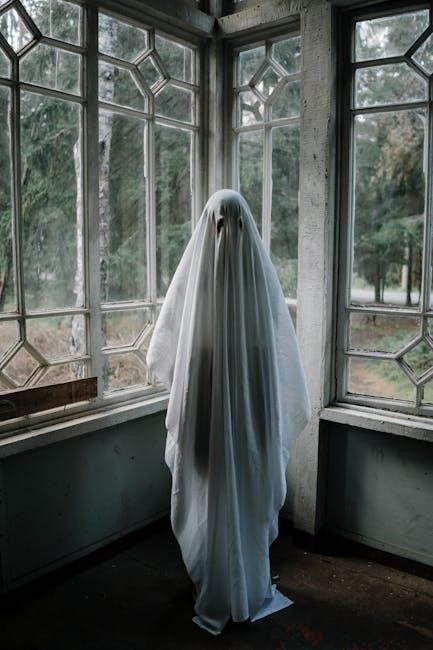Edgar Allan Poe’s The Fall of the House of Usher is a masterpiece of Gothic horror, exploring themes of decay, madness, and psychological turmoil. Published in 1839, it remains one of Poe’s most enduring works, captivating readers with its haunting atmosphere and intricate symbolism. The story delves into the crumbling Usher mansion and the tragic fate of its inhabitants, reflecting Poe’s mastery of suspense and psychological depth. This chilling tale continues to resonate, offering profound insights into human fragility and the darker aspects of the human experience.
1.1. Biographical Background of Edgar Allan Poe
Edgar Allan Poe (1809–1849) was a pioneering American writer, poet, and literary critic. Orphaned at three, Poe faced a tumultuous life marked by poverty and personal loss. His work as a writer and editor laid the groundwork for modern detective fiction and Gothic literature. Known for his dark, psychologically complex themes, Poe’s life mirrored the tragedy found in his works, ending in mysterious circumstances at age 40. His legacy endures as a master of macabre and suspense.
1.2. Historical Context and Publication History
The Fall of the House of Usher was first published in 1839 in Burton’s Gentleman’s Magazine, where Poe served as an editor. This period marked Poe’s rising influence in Gothic literature, with the story quickly gaining recognition for its eerie atmosphere and psychological depth. Its publication solidified Poe’s reputation as a master of the macabre, and it remains a cornerstone of his oeuvre, widely studied for its themes and symbolic richness.
1.3. Significance of The Fall of the House of Usher in Poe’s Works
The Fall of the House of Usher stands as one of Poe’s most iconic tales, exemplifying his mastery of Gothic horror and psychological exploration. It showcases his ability to weave intricate symbolism and atmospheric tension, cementing his legacy as a pioneer of the genre. The story’s themes of decay, madness, and isolation resonate deeply, making it a cornerstone of Poe’s oeuvre and a defining work in American literature.

Setting and Atmosphere
The story’s setting, an isolated, crumbling mansion surrounded by dark woods and a tarn, creates a foreboding atmosphere of decay and madness, mirroring the Usher family’s downfall.
2.1. Description of the Usher Mansion and Its Symbolism
The Usher mansion, with its ancient, decaying architecture, symbolizes the family’s decline. Its towering spires, crumbling walls, and eerie facade mirror Roderick’s mental deterioration and the family’s cursed legacy. The house’s labyrinthine interior, with its dark corridors and hidden chambers, reflects the characters’ psychological entrapment. Its physical decay foreshadows the inevitable collapse, both of the structure and the Usher lineage, embodying themes of decay and madness.
2.2. The Role of the Surrounding Landscape
The desolate landscape surrounding the Usher mansion, with its dark, gloomy woods and a black tarn, mirrors the decay and madness within. The eerie environment enhances the story’s oppressive atmosphere, reflecting the characters’ psychological turmoil. This setting isolates the Ushers, deepening the sense of despair and inevitability, crucial to the narrative’s Gothic horror.
2.3. The Impact of Setting on the Story’s Mood
The crumbling mansion and eerie landscape create a foreboding atmosphere, immersing readers in a sense of dread. The decaying house, with its dark, oppressive presence, mirrors the Usher family’s psychological turmoil. Shadows, silence, and the tarn’s murky waters amplify the mood of claustrophobia and impending doom, drawing readers into the story’s haunting world and intensifying its themes of madness and despair.

Major Characters
Roderick Usher, Madeline Usher, and the narrator are central to the story. Roderick, ailing and hypersensitive, struggles with mental decay. Madeline, his enigmatic twin, embodies mystery and tragedy. The narrator, a detached observer, chronicles their doomed fate, bridging reality and horror.
3.1. Roderick Usher: Personality, Illness, and Downfall
Roderick Usher, a man of refined sensibility, is tormented by a mysterious illness. His pale, emaciated appearance reflects his mental and physical decay. He suffers from heightened sensitivity, hypochondria, and a growing sense of doom. His artistic temperament clashes with his morbid disposition, leading to a descent into madness. His condition worsens, mirroring the crumbling house, symbolizing his inevitable downfall and the disintegration of his family’s legacy.
3.2. Madeline Usher: Her Role and Mystique
Madeline Usher, Roderick’s twin sister, is a figure of mystery and tragedy. Her illness and eventual death deepen the story’s supernatural elements. Her reappearance after being entombed shocks Roderick, accelerating his madness. Madeline’s character embodies the enigmatic and the macabre, leaving a lasting impact on the narrative and its themes of loss and psychological unraveling.
3.3. The Narrator: Perspective and Involvement
The narrator serves as a detached observer, offering an objective perspective on the eerie events. His curiosity drives the plot forward, yet he remains emotionally distant, allowing readers to witness the unfolding tragedy through his lens. His rational mindset contrasts with Roderick’s instability, providing a grounding force amidst the surreal chaos. The narrator’s involvement highlights the blurred lines between reality and madness, enhancing the story’s psychological depth and suspense.

Themes
The story explores themes of decay, isolation, madness, and the supernatural, delving into the fragility of the human psyche and the inevitability of decline.
4.1. Decay and the Disintegration of the Human Spirit
The story vividly portrays the decay of the Usher family, both physically and spiritually, reflecting the inevitable disintegration of their ancestral lineage. The crumbling mansion mirrors Roderick’s mental deterioration, while Madeline’s mysterious illness symbolizes the family’s doomed fate. Their isolation accelerates their decline, emphasizing the destructive power of unchecked decay. Poe masterfully intertwines the physical and psychological, illustrating how internal rot leads to irreversible collapse, leaving no escape from the shadows of their haunting legacy.
4.2. Isolation and Its Destructive Power
The Usher mansion’s isolation in a desolate landscape reflects the family’s emotional and physical detachment. Roderick and Madeline’s seclusion accelerates their mental decline, fostering paranoia and despair. Poe illustrates how isolation breeds madness, as the characters’ inability to connect with the outside world intensifies their inner turmoil. This destructive power of isolation ultimately leads to their tragic downfall, emphasizing its role in the story’s dark and unsettling narrative.
4.3. Madness and the Blurred Line Between Sanity and Insanity
Roderick Usher’s mental instability and Madeline’s mysterious illness exemplify the fragility of the human mind. Their conditions blur the line between sanity and madness, as Roderick’s paranoia intensifies and Madeline appears to transcend death. Poe masterfully portrays how isolation and fear can erode rationality, leaving the characters trapped in a realm where reality and delusion intertwine. This psychological unraveling underscores the destructive power of unchecked mental anguish and the inevitability of collapse.

Symbols and Imagery
The Fall of the House of Usher is rich in symbolic imagery, with the decaying mansion mirroring the Usher family’s decline. The house, with its cracked walls and haunting presence, symbolizes the crumbling psyche of its inhabitants. The storm and the tarn reflect the turmoil and doom, while the painting of haunted eyes embodies the family’s dark legacy and inescapable fate.
5.1. The House as a Symbol of the Usher Family’s Decline
The Usher mansion serves as a powerful symbol of the family’s physical and psychological decay. Its crumbling facade, with fissured walls and fading grandeur, mirrors Roderick’s mental deterioration and the family’s dwindling legacy. The house’s isolation and eerie presence heighten the sense of doom, while its eventual collapse signifies the irreversible downfall of the Usher lineage. It stands as a haunting metaphor for the fragility of human sanity and the inevitability of decay.
5.2. The Storm and Its Significance
The storm in The Fall of the House of Usher is a potent symbol of the turmoil within the Usher family. Its ferocity mirrors the escalating tension and madness, creating an ominous backdrop for the story’s climax. The storm’s arrival coincides with the peak of Roderick’s anxiety, suggesting a connection between the external chaos and his internal psychological state. It serves as both a harbinger of doom and a force that unleashes the family’s dark secrets, culminating in the house’s collapse and the Ushers’ tragic fate.
5.3. The Painting of the Haunted Eyes
The painting of the haunted eyes symbolizes the oppressive presence of the past and the Usher family’s entrapment in their dark legacy. Its unsettling gaze reflects Roderick’s preoccupation with his family’s history and foreshadows the tragic events. The spectral eyes embody the inescapable burden of the Ushers’ cursed lineage, serving as a visual reminder of their doomed fate and the supernatural forces that haunt them.

Literary Devices
Poe masterfully employs vivid imagery, foreshadowing, and suspense to craft a chilling atmosphere. These devices heighten tension and immersion, drawing readers into the story’s dark, psychological landscape.
6.1. Foreshadowing and Suspense
Poe skillfully employs foreshadowing to build suspense, hinting at the tragic fate of the Usher family. The crumbling house, with its eerie atmosphere, symbolizes impending doom. Roderick’s mysterious illness and Madeline’s premature burial foreshadow her return, while the storm mirrors the escalating chaos. These techniques create a sense of dread, keeping readers engaged and anticipating the story’s dark conclusion.
6.2. Vivid Imagery and Sensory Details
Poe’s rich imagery immerses readers in the decaying Usher mansion, evoking unease through descriptions of crumbling walls, dark tarns, and flickering shadows. Sensory details like the musty odor, echoing silence, and flickering candlelight heighten the oppressive atmosphere. These elements engage multiple senses, creating a vivid experience that underscores the story’s themes of decay and madness, drawing readers deeper into the haunting world of the Ushers.

The Narrator’s Role and Perspective
The narrator serves as both observer and participant, offering a detached yet curious perspective. His visits to the Usher mansion provide insight into the eerie atmosphere.
7.1. The Narrator as a Foil to Roderick Usher
The narrator’s rationality contrasts with Roderick’s growing madness, highlighting the fragility of sanity. While Roderick descends into despair, the narrator remains detached, offering a grounded perspective. This contrast underscores the psychological unraveling of the Usher family, emphasizing the narrator’s role as an outsider witnessing the eerie and tragic events unfold within the crumbling mansion.
7.2. The Narrator’s Detachment and Curiosity
The narrator’s emotional detachment allows him to observe events objectively, yet his curiosity drives him to uncover the mysteries of the Usher family. His dual nature—both distant and engaged—enables him to document the unfolding tragedy while remaining unaffected by its horror. This balance of traits makes him an effective chronicler of the story’s eerie and psychological dynamics.

Key Moments and Their Analysis
The narrator’s arrival, Madeline’s death, and her mysterious return are pivotal moments that escalate tension and reveal the intertwining of physical and psychological decay, culminating in the house’s collapse.
8.1. The Narrator’s Arrival and First Impressions
The narrator arrives at the Usher mansion, struck by its eerie and decaying appearance. The house seems alive, exuding a sense of gloom and mystery. Upon meeting Roderick, the narrator notices his friend’s fragile mental state and physical decline. Roderick’s unsettling demeanor and the mansion’s oppressive atmosphere create a sense of foreboding. The narrator feels a mix of curiosity and unease, setting the tone for the unfolding tragedy.
8.2. Madeline’s Death and Its Aftermath
Madeline’s death marks a turning point, intensifying the eerie atmosphere. Roderick, overwhelmed by grief, entombs her in the family vault, believing she is merely cataleptic. This act deepens his psychological turmoil, as he becomes increasingly unhinged. The narrator witnesses Roderick’s spiraling madness, while the mansion itself seems to mirror the decay of its inhabitants. Madeline’s supposed death and entombment set the stage for the story’s tragic climax.
8.3. The Collapse of the House
The collapse of the Usher mansion symbolizes the final disintegration of the Usher family and their dark legacy. As the storm rages, the house crumbles, entombing Roderick and Madeline. The narrator witnesses the horrific sight, emphasizing the story’s climax. The house’s destruction mirrors the decay of its inhabitants, marking the end of the Usher lineage. This event underscores the inescapable fate of decay and madness, leaving a chilling and indelible impression on the reader.

The Relationship Between Roderick and Madeline
Roderick and Madeline share an intense emotional bond as inseparable twin siblings, their relationship marked by mutual dependence and a mysterious, unspoken connection that ultimately seals their tragic fate.
9.1. Their Shared Illness and Emotional Bond
Roderick and Madeline Usher suffer from a mysterious, debilitating illness that intertwines their physical and emotional states. Their bond is rooted in a deep, almost supernatural connection, reflecting Poe’s exploration of psychological and physical interdependence. This shared affliction amplifies their isolation, creating a tragic dynamic where their illnesses mirror each other, ultimately leading to their shared downfall. Their relationship is both intimate and destructive, a central element of the story’s Gothic tragedy;
9.2. The Tragic Consequences of Their Relationship
The intense bond between Roderick and Madeline Usher leads to devastating consequences, as their shared illness and isolation deepen their psychological and physical decline. Their relationship accelerates the family’s downfall, culminating in the collapse of the house and their entombment together. This tragic end underscores the destructive power of their interdependence, symbolizing the inescapable fate tied to their bond and the ultimate destruction of the Usher legacy.
Edgar Allan Poe’s The Fall of the House of Usher concludes with a haunting exploration of decay, madness, and isolation, leaving a lasting impact on Gothic literature.
10.1. The Enduring Legacy of The Fall of the House of Usher
The Fall of the House of Usher remains a cornerstone of Gothic literature, influencing countless adaptations and works. Its exploration of mental decay, isolation, and the supernatural continues to captivate audiences, ensuring its timeless relevance. Poe’s mastery of atmosphere and symbolism has solidified the story’s place in literary history, making it a seminal work studied and cherished across generations.
10.2. Final Thoughts on the Story’s Themes and Impact
The Fall of the House of Usher leaves a lasting impact through its profound exploration of human frailty and psychological complexity. Its themes of decay, isolation, and madness resonate universally, inviting readers to reflect on the darker aspects of existence. Poe’s masterful storytelling and atmospheric depth ensure the story’s enduring relevance, making it a timeless classic that continues to captivate and unsettle audiences, inspiring new adaptations and interpretations across generations.